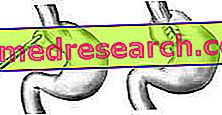Generality
Laryngospasm is the involuntary / uncontrolled contraction of the laryngeal muscles, followed by a narrowing or closure of the glottis and / or vocal cords. The result is a feeling of suffocation and an inability to speak.

Figure: a terrifying sense of suffocation and the inability to speak accompany laryngospasm episodes
Laryngospasm can be caused by various causes: asthma, allergic reactions, lack of calcium in the blood, inhalation of irritating substances, gastro esophageal reflux disease, pharyngo-laryngeal reflux, general anesthesia, etc.
Although laryngospasm is usually a short-lived episode (less than 60 seconds shortness of breath, one or two minutes for normal breathing), the patient spends a moment of intense fear.
The treatment of laryngospasm depends on the triggering causes (causal therapy).
Brief anatomical reference to the larynx
The larynx is an unequal tube of tubular form, located at the level of the neck, before the beginning of the trachea . It represents the last tract of the upper airways and consists of several cartilaginous structures, held together by a series of muscles and ligaments.
Seat of the vocal cords, the larynx performs three fundamental functions:
- It channels the air towards the trachea, then towards the lungs.
- It allows speech, through the vibration of the vocal cords.
- Thanks to a cartilage valve called epiglottis, it prevents food, which is about to be swallowed, from entering the trachea and obstructing the airways.

Figure: the larynx and the main cartilaginous structures that constitute it are highlighted in red. As can be seen, the larynx is placed at the beginning of the trachea, bordered at the top with the pharynx and is in front of the esophagus, which is the first tract of the digestive canal. From the site: ponsuke2.s98.xrea.com

Figure: the larynx and vocal cords. From the site: ponsuke2.s98.xrea.com
Externally, the larynx can be placed at the so-called Adam's apple (anterior protrusion of the neck more evident in men than in women).
What is laryngospasm?
Laryngospasm is the involuntary / uncontrolled contraction of the laryngeal muscles, with consequent narrowing or closure of the glottis and / or vocal cords. This determines the momentary block (less than 60 seconds) of breathing: the inhaled air, in fact, cannot reach the lungs because the laryngeal musculature remains contracted preventing its passage towards the lower airways (trachea, bronchi, etc.).
Causes
Laryngospasm is associated with several morbid circumstances, but not only. It may, in fact, be due to:
- Allergic reactions
- Asthma
- Conditions that cause hypocalcemia (blood calcium defect)
- Inhalation of irritating substances, such as cigarette smoke, dust, toxic fumes, etc.
- Physical exercise
- Involuntary inhalation of mucus, blood, water or objects
- Gastroesophageal reflux disease
- Pharyngo-laryngeal reflux
- General anesthesia
Gastroesophageal reflux disease, pharyngo-laryngeal reflux and general anesthesia will be discussed in more detail, as the first two situations are the main causes of laryngospasm, while the latter can be life threatening, especially for children.
Causes of hypocalcemia:
- Hypoparathyroidism
- Wrong diet (malnutrition or malabsorption)
- Vitamin D deficiency
- Intestinal resection
- Rickets
- Excess of phosphorus
- Chronic magnesium deficiency
However, before the investigation, it should be remembered that laryngospasm can arise even without a precise reason.
GASTROESOPHAGEAL REFLUX DISEASE
Gastroesophageal reflux disease is caused by the excessive and chronic rise in the esophagus of the acid contents of the stomach.
The esophagus is the channel that connects the mouth to the stomach; the frequent presence, in its interior, of acid substances coming from the stomach, inflames the mucous walls ( esophagitis ) causing, on the reflex, a spasm of the vocal cords. This spasm causes the glottis to close momentarily, hence the laryngospasm event.
Warning: according to experts, one of the possible causes of sudden infant death is laryngospasm caused by gastroesophageal reflux disease.
FARINGO-LARINGEO REFLUX
Pharyngo-laryngeal reflux is the disorder in which the acidic contents of the stomach rise up through the esophagus to the pharynx and larynx.
The structures that make up the larynx are very delicate and sensitive (even more than the inner walls of the esophagus); therefore, contact with acidic substances easily determines its closure from muscle spasm.
GENERAL ANESTHESIA
General anesthesia is a procedure practiced before particularly invasive surgical operations, in order to put the patient to sleep and make him immobile and insensitive to pain.
After being asleep, the patient is intubated to allow the so-called mechanical ventilation: he, in fact, without intubation (which consists of inserting a tube into the trachea) and mechanical ventilation, would not be able to breathe autonomously and effective.
At the end of the surgical operations, the extraction of the tube from the trachea could, in some rare cases, irritate the vocal cords and cause a spasm of the laryngeal muscles, with consequent temporary blockage of respiration.
Laryngospasm due to general anesthesia is a possible cause of death in children undergoing surgery, as it could cause cardiac arrest within 30-40 seconds.
Symptoms and Complications
The symptoms that characterize laryngospasm are a terrifying sense of suffocation and the inability to speak .
Since the appearance of such sensations is sudden, it is very probable that the patient becomes agitated and instinctively brings his hands to his throat as if to remove the obstacle.
As anticipated, the duration of laryngospasm is 60 seconds or less, therefore the complete respiratory faculties are reacquired within a maximum of one or two minutes.
As the breath normalizes, inhalation and exhalation are characterized by a noise similar to something that screeches ( stridor ). As the minutes pass, the stridor shrinks more or less slowly, until it disappears.
OTHER SYMPTOMS
Being often a consequence of some morbid states, laryngospasm is also commonly accompanied by the characteristic symptoms of what caused its appearance. Therefore, to cite an example, in the case of gastroesophageal reflux disease the patient may experience (in addition to the effects of laryngospasm) the following disorders:
- Chest pain
- Cough
- Difficulty swallowing
- Stomach ache
- Hoarseness
- Nausea
- Sore throat
- Need to clear the voice frequently
WHEN DO THE EPISODES OF LANGUAGE SPAS occur?
Episodes of laryngospasm can occur at any time of the day. When they occur at night ( nocturnal laryngospasm ), the affected person awakens, because the feeling of suffocation is very strong indeed.
COMPLICATIONS
Complications appear if laryngospasm is lasting.
In fact, such an eventuality can result, in sequence: turgid veins of the neck, pallor, cyanosis, cold sweats, irregular pulse, loss of consciousness, convulsions and death by suffocation .
However, laryngospasm episodes (ie shortness of breath) are usually interrupted before the aforementioned effects occur.
Diagnosis
To diagnose an episode of laryngospasm, the doctor is generally based on the patient's description of the symptoms and feelings experienced.
If the phenomenon is recurrent, it is necessary to carry out in-depth examinations, in order to understand what are the triggering causes ( causal diagnosis ). Among the various controls performed, we point out the allergic tests and the esophagus-gastro-duodenoscopy (more simply gastroscopy ).
Once the factors causing repeat laryngospasm episodes have been established, the most appropriate therapy can be planned.
Treatment
When laryngospasm occurs without a precise cause, it is sufficient to wait for it to resolve spontaneously; as a matter of fact, in fact, its passage does not leave any consequence on the person affected, if not the strong fear.
When, on the other hand, laryngospasm is associated with particular morbid states, it is good to practice a causal therapy, that is a therapy aimed at resolving the triggers.
IN CASE OF GASTROESOPHAGEAL REFLUX OR Pharyngolaryngeal
If the cause of the laryngospasm episodes is the ascent of the gastric contents towards the esophagus and / or the larynx, the doctor could prescribe a drug therapy based on:
- Proton pump inhibitors (IPP), such as esomeprazole and lansoprazole . Their function is to reduce acid production in the stomach.
- Anti-H2 (or H2-receptor antagonists), such as ranitidine . They act very similarly to proton pump inhibitors, thus reducing the production of acid secretions in the stomach.
- Antacids, such as magnesium hydrate or aluminum hydroxide . They are used to temporarily buffer the gastric acidity (ie the stomach) and relieve the problems of poor digestion (heartburn).

- Prokinetics, such as domperidone and metoclopramide . They serve to promote the progression of food at the gastrointestinal level. Doubts still remain about their real effectiveness in case of gastroesophageal reflux disease and in case of pharyngo-laryngeal reflux.
If these treatments do not provide satisfactory results and the problem persists, it may be necessary to resort to surgery. The operation performed in such eventualities is the laparoscopic fundoplication, which consists in wrapping and suturing, around the last section of the esophagus, the upper part of the stomach, in such a way as to offer greater resistance to acid reflux coming from the stomach .
Some tips on diet and habits to be taken in case of acid reflux from the stomach
In the event of acid substances rising from the stomach to the esophagus and possibly the larynx, doctors recommend:
- Not smoking
- Avoid drinking fizzy drinks, alcohol (any type) and fruit juices (especially citrus)
- Avoid drinking coffee
- Split daily meals and prefer low-fat foods
- Avoid eating certain foods, such as chocolate and tomato
- Lose weight if you suffer from overweight or obesity
IN CASE OF GENERAL ANESTHESIA
If laryngospasm is induced by general anesthesia, action must be taken immediately, especially if the patient is a child.

Figure: hyperextension maneuver of the neck, to favor the passage of air through the airways (or respiratory tract). From the site: viaaereadificil.com.br
The two basic steps are: hyperextension of the neck (delicate maneuver with which the chin is raised to favor the passage of air through the respiratory tract) and administration of oxygen ( oxygen therapy ). If these remedies are not sufficient (a very serious eventuality), the administration (by intramuscular, intraosseous or intralingual) of succinylcholine, ie a muscle relaxant, and re- intubation, is required to guarantee mechanical ventilation again.
OTHER SPECIAL SITUATIONS
If the laryngospasm episode is due to sporadic inhalation of irritating substances, it is advisable to drink water as soon as breathing resumes. Taking liquids on these occasions serves to "clean up" the larynx.
If at the beginning there is a condition of hypocalcemia, to promote relaxation of the laryngeal muscles, calcium gluconate is administered by venous injection.
Finally, if the laryngospasm attack occurs at night, interrupting sleep, it is advisable not to get excited and calmly wait for normal breathing to resume.
Prognosis
Although it is a rather trying experience that leaves its mark, only on very rare occasions does laryngospasm cause death by asphyxiation (or suffocation).




